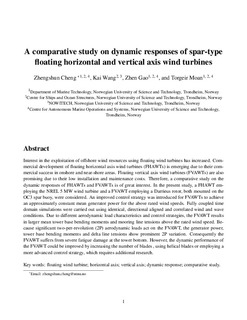A comparative study on dynamic responses of spar-type floating horizontal and vertical axis wind turbines
Journal article, Peer reviewed
Accepted version
Date
2017Metadata
Show full item recordCollections
- Institutt for marin teknikk [3472]
- Publikasjoner fra CRIStin - NTNU [38688]
Abstract
Interest in the exploitation of offshore wind resources using floating wind turbines has increased. Commercial development of floating horizontal axis wind turbines (FHAWTs) is emerging because of their commercial success in onshore and near-shore areas. Floating vertical axis wind turbines (FVAWTs) are also promising because of their low installation and maintenance costs. Therefore, a comparative study on the dynamic responses of FHAWTs and FVAWTs is of great interest. In the present study, a FHAWT employing the 5MW wind turbine developed by the National Renewable Energy Laboratory (NREL) and a FVAWT employing a Darrieus rotor, both mounted on the OC3 spar buoy, were considered. An improved control strategy was introduced for FVAWTs to achieve an approximately constant mean generator power for the above rated wind speeds. Fully coupled time domain simulations were carried out using identical, directional aligned and correlated wind and wave conditions. Because of different aerodynamic load characteristics and control strategies, the FVAWT results in larger mean tower base bending moments and mooring line tensions above the rated wind speed. Because significant two-per-revolution aerodynamic loads act on the FVAWT, the generator power, tower base bending moments and delta line tensions show prominent two-per-revolution variation. Consequently, the FVAWT suffers from severe fatigue damage at the tower bottom. However, the dynamic performance of the FVAWT could be improved by increasing the number of blades, using helical blades or employing a more advanced control strategy, which requires additional research.
